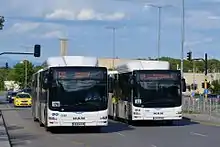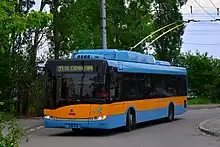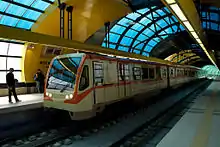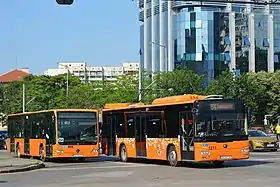Sofia Public Transport
The Sofia Urban Mobility Center (SUMC) (Bulgarian: Център за градска мобилност) is the transit authority responsible for public transport in Sofia, the capital of Bulgaria. It is one of the municipal companies controlled by Stolichna Municipality.
 | |
 Headquarters of SUMC in 2009 | |
Native name | Център за градска мобилност |
|---|---|
| Formerly | SKGT |
| Type | Joint-stock company |
| Founded | 2 February 2009 |
| Headquarters | , |
Key people | Dimitar Dilchev, executive director |
| Services | transport services |
| Owner | Stolichna Municipality |
| Website | www |
SUMC operates an extensive bus system, 15 tram lines, a trolleybus system and a metro system.
History
SUMC was created through the merger of the companies "Stolichna kompaniya za gradni transport - Sofia" EOOD and "Parkings and garages" EAD at the beginning of 2009. It deals with:
- the organization and control over the activity of public transport in Sofia, including bus, trolleybus, tram transport and metro;
- control of transport in the city;
- construction and operation of parking spaces in the capital, etc.
Transport
The public transport in Sofia consists of a comprehensive network of bus, trolleybus, tram and metro lines. It is overseen by the Sofia Urban Mobility Center, a municipal enterprise responsible for route planning, scheduling, fare collection and ticket inspection. It also pays the various transport operators for their service on a per-kilometer basis. Sofia is the only city in Bulgaria that operates the four modes of public transport.[1]
As of 2023, public transport in Sofia is operated by 3 municipal and 1 private company:
- Sofia Public Bus Transport Company JSC (Bulgarian: Столичен автотранспорт ЕАД) operates the majority of bus services
- Sofia Public Electrical Transport Company JSC (Bulgarian: Столичен електротранспорт ЕАД) operates the tram and trolleybus networks
- Metropoliten JSC (Bulgarian: Метрополитен ЕАД) operates the Sofia Metro
- Private company MTK Group operate some, mainly suburban, bus services
Buses

The public bus transport in Sofia developed relatively late compared to the other types of transport in the city. The first operational line was opened on 20 April 1935. Soon after that six more lines were opened, bringing the total network length to 23 km.[2]
During the communist era, the bus fleet consisted mainly of Ikarus and Bulgarian-made Chavdar buses. After the political changes in 1989, however, the fleet has gradually been modernised.
Today the system presently comprises 98 routes with 2,380 km system length.
Trolleybuses

Trolleybus transport was the last form of surface public transport to develop in Sofia, after buses and trams. The first Sofia trolleybus line opened on 8 February 1941. It was over 3 km (2 mi) long, and connected the city with the Gorna Banya quarter. The line was covered by 2 MAN trolleybuses, which were stored on the last stops during the night, due to the lack of depot.
In the 1950s and 1960s, massive development of the trolleybus transport in Sofia began. At that time, the construction of new trolleybus routes proceeded especially rapidly, and two depots ("Stochna Gara" and "Nadezhda") were opened, with a total capacity of 160 trolleybuses. In 1951, the first Bulgarian made trolleybuses entered service.
In 1987, a new depot, "Iskar", was opened with a capacity of 130 trolleybuses. Levski depot was opened in 1994 with capacity of 60 trolleybuses. As of 2021 three depots are in operation: Nadezhda, Iskar and Levski. The latter also serves as a storage and overhaul facility.
Today the system presently comprises 10 routes with 193 km route length.
Trams

Trams began operation on January 1, 1901.[3] As of 2006, the tram system included approximately 308 kilometres (191 miles)[3] of narrow and standard gauge one-way track.[3] Most of the track is a narrow gauge (1,009 mm or 3 ft 3+23⁄32 in), with standard gauge (1,435 mm or 4 ft 8+1⁄2 in) used on lines 20, 22 and 23 and accounting for approximately 40 kilometres (25 mi) of the system's track length.[3]
The average speed of trams in Sofia as of 2020 is 14 km/h.
For comparison (2010), the subway in Sofia moves at 38.84 km/h, and the buses – at 19.4 km/h.
Today the system presently comprises 15 routes with 308 km track length.
Metro
The Sofia Metro is the only metro in Bulgaria. It began operation on 28 January 1998.[4] As of 2023, the Sofia Metro consists of four interconnected lines, serving 47 stations, with a total route length of 52.0 kilometres (32.3 mi)[4][5] and also being among the top 20 of the most extensive European metro systems, ranking 19th as of 2020. The Metro links the densely populated districts of Lyulin – Mladost (M1 line – Red) and Nadezhda – Lozenets (M2 line – Blue), and serves the Sofia Airport.[6][7]
Today the system has 4 lines with 52 km system length.
See also
References
- Eurotransport magazine issue 6, 2015 ISSN 1478-8217
- History of the bus transport in Sofia
- "Urban transport - History of Sofia Trams". Sofia Urban Mobility Center. 2013. Retrieved 2013-09-10.
- "General Info about Sofia Metro". MetroSofia.com. 2013. Retrieved 2013-09-20.
- "Председателят на комисията Жозе Мануел Барозу ще пререже лентата на втория лъч на подземната железница" [We want the [European Commission (EC)] 800 million for the third metro line] (in Bulgarian). Строител. 30 July 2012. Retrieved 2013-09-20.
- "Subway Trains to Sofia Airport Start Running at 1 pm on April 2". novinite.com. 2 April 2015. Retrieved 2015-04-07.
- "Sofia airport metro link opens". Railway Gazette International. 7 April 2015. Retrieved 2015-04-07.

